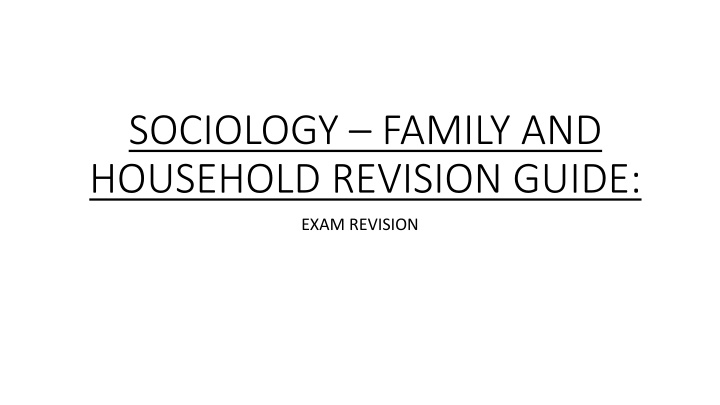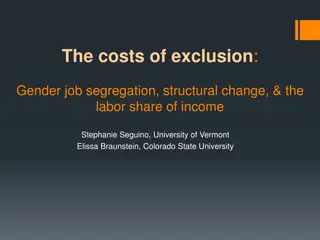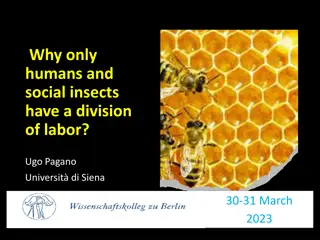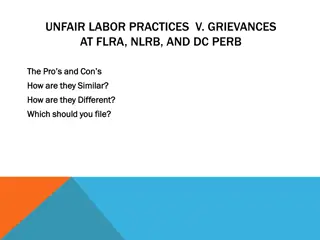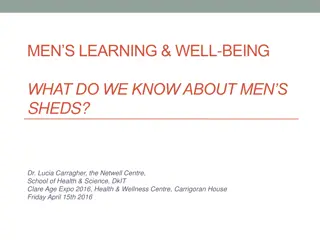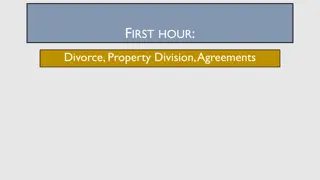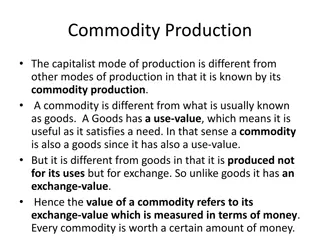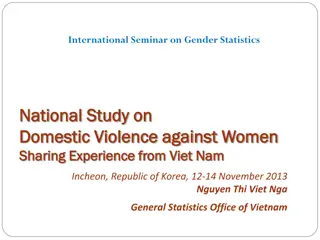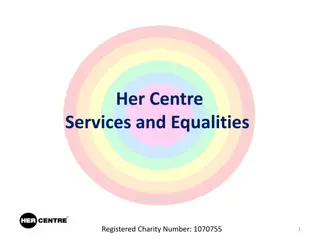Role of Men and Women in Domestic Division of Labor
The domestic division of labor encompasses the roles of men and women in housework, with traditional views promoting segregated conjugal roles and newer perspectives suggesting symmetrical family dynamics. While functionalists like Parsons argue for distinct roles based on gender, feminists challenge this notion, highlighting persisting inequalities within the household. Studies by various sociologists provide insights into the evolution of domestic roles and the ongoing debate regarding gender equality in family responsibilities.
Uploaded on Aug 24, 2024 | 1 Views
Download Presentation

Please find below an Image/Link to download the presentation.
The content on the website is provided AS IS for your information and personal use only. It may not be sold, licensed, or shared on other websites without obtaining consent from the author.If you encounter any issues during the download, it is possible that the publisher has removed the file from their server.
You are allowed to download the files provided on this website for personal or commercial use, subject to the condition that they are used lawfully. All files are the property of their respective owners.
The content on the website is provided AS IS for your information and personal use only. It may not be sold, licensed, or shared on other websites without obtaining consent from the author.
E N D
Presentation Transcript
SOCIOLOGY FAMILY AND HOUSEHOLD REVISION GUIDE: EXAM REVISION
TOPIC 1: TOPIC 1: COUPLES EXAM REVISION
THE DOMESTIC DIVISION OF LABOUR: THE DOMESTIC DIVISION OF LABOUR: Domestic division of labour refers to the roles that men and women play in housework. JOINT AND SEGREGATED CONJUGAL ROLES: Elizabeth Bott (1957) distinguishes between two types of conjugal roles; that is, roles within marriage: PARSONS: INSTRUMENTAL AND EXPRESSIVE ROLES In traditional nuclear family, role of the husband and wife are segregated. Parsons (1955) a functionalist, argues there is a clear division of labour in the family. 1. Segregated Conjugal Roles: Couples have segregated roles. A male breadwinner & A female homemaker/carer as Parsons instrumental and expressive roles. Their leisure time was also separated. 1. Instrumental role: The husband has an instrumental role = Towards achieving success and financially providing for the family he is the breadwinner. 2. Expressive role: The wife has the expressive role = Providing primary socialisation for children and meeting family s emotional needs she is the Home-maker & full-time housewife. Parsons argues division of labour is based on biological differences women naturally suited to the expressive role. Men are naturally the providers. He argues division of labour is beneficial to both men and women and to their children. The Conservatives and the New Right, hold this view. 2. Joint Conjugal Roles: Where couples share tasks such as housework & childcare spend their leisure time together. Young & Willmott Identified pattern of segregated conjugal roles in study of W/C families, in Bethnal Green. (Men were breadwinners, and women were homemakers). Criticisms: Young & Willmott (1962) argue men are now taking greater share of domestic tasks and more wives are becoming breadwinners. Feminists reject Parsons view, that division of labour is natural they argue it only benefits men because women are exploited.
THE SYMMETRICAL FAMILY: A FEMINIST VIEW TO HOUSEWORK: Feminists reject the march of progress view. They argue there is little change in the role of women within the home. They see inequality in the family as a result of male dominated society. Women occupy a subordinate and dependent role in the family. Ann Oakley (1974) criticises Young & Willmott = She argues their claims are exaggerated. Although Oakley found Husbands helped wives with childcare around the house it doesn t equate to the amount work women complete in the home. Oakley found Husbands helping in the home, but now trend towards symmetry. Only 15% of Husbands had high level of involvement in housework. Men playing with the children, takes away from the mothers want to be involved with their childcare, they become left with housework. Mary Boulton (1983) found fewer than 20% of men had a major involvement in childcare. She argues Young & Willmott exaggerate men s involvement in childcare they ignore their housework responsibilities. Alan Warde & Kevin Hetherington (1993) found sex-typing within the family. Women were 30 time more likely to have finishing completing domestic tasks within the home, e.g washing and cleaning. Warde & Hetherington found men only completed female tasks when women were not at home to do it. Young & Willmott (1973) take a march of progress view . They see the family as gradually improving for all its members including women. Family is becoming more equal and democratic. Long term trend away from segregated roles and now symmetrical. Symmetrical family = roles are more similar, not the same. Evidence: 1. Women now go out to work, although this is part time, rather than full time. 2. Men now help with housework and childcare. 3. Couples now spend their leisure time together instead of separately with workmates or female relatives. Young & Willmott found symmetrical family evident in young couples those who are more affluent (better off). Young & Willmott see a symmetrical nuclear family increase as a result of major social changes: 1. Changes in women's position marriage and women working. 2. Geographical mobility more couples living away from the communities in which they grew up. 3. New technology and labour saving devices. 4. Higher standards of living. Many of these factors are inter-linked = Married women bringing in second wage, raises the families standards of living, allows couple to buy labour saving devices, thus encourages men to do more.
ARE COUPLES BECOMING MORE EQUAL? ARE COUPLES BECOMING MORE EQUAL? THE MARCH OF PROGRESS VIEW: THE FEMINIST VIEW: For feminists, women going into paid work has not led to great equality. There is also little sign of the new man = that completes housework and childcare. Women now carry dual burden = Paid work and Emotional work. British Survey found in 2012, men did 8 hours of housework a week, women did 13 hours & Men spent 10 hours looking after the family, women spend 23 hours. Women overall do more work than men in the family (twice as much). Couples still have division of labour = women more likely to do laundry and washing up. Allan (1985) = Women are less intrinsically satisfied from washing and cleaning. Sociologists argue women working is leading to Young & Willmott s symmetrical family. In this march of progress view = men are becoming more involved in paid work and childcare. Gershuny (1994) argues that women working full-time is leading to an equal division of labour in the home = he argued these type of women did less domestic work than non- employed women. Sullivan s study (200) found a trend of women doing less domestic work and men doing more men were participating in traditional female tasks. Trends reflect changes in attitude to division of labour. Less people believe it is the man s job to provide for the family it is seen as a joint form of roles. TAKING RESPONSIBILITY FOR CHILDREN: Boulton (1983) points out although fathers help with some tasks, mothers still have the burdens of looking after the family. Boulton s view is supported by a number of studies: 1. Ferri & Smith (1996) = argue fewer than 4% of fathers took part in family childcare. 2. Dex & Ward (2007) = found fathers had high involvement with children no involvement in looking after the sick. 3. Braun, Vincent & Ball (2010) = found 3/70 families showed father s involvement in childcare. Emotion work & Triple shift:Hochschild (2013) calls emotion work = taking responsibility of family members. Duncombe & Marsden (1995) = Talks about triple shift Paid work, housework and emotion work.
EXPLAINING THE GENDER DIVISON OF LABOUR: Crompton & Lyonette (2008) = Identity 2 different explanations of unequal division of labour. 1. The cultural or Ideological explanation of inequality: Division of labour is determined by patriarchal norms and values. (Women complete domestic tasks because society expects them to). 2. Material or economic explanation of inequality: Women generally earn less than work, while men spend more of their time working. Evidence for the cultural explanation: Equality will only be achieved when norms about gender roles change. (Changes in men & women s attitudes, values + expectations). Gershuny (1994) = Couples whose parents shared roles more likely to share roles themselves. Gillian Dunne (1999) = Lesbian couples had more symmetrical relationships because there were no traditional gender scripts linked to Heterosexual relationships. Evidence for the material explanation: Kan: The more paid work women do, the less housework they complete. Sullivan: Working full-time & part-time affects the amount of domestic work couples do. Women being in paid work has led to equality within family. TAKING RESPONSIBILITY FOR QUALITY TIME : Southerton (2011) = Mothers were in charge of looking after quality time. Parents both working = makes it harder for scheduling quality time together. Working mothers always busy to then plan an outing. Southerton found that men would do different leisure's to women = women always have to involve their children. Summary: Evidence shows movement towards symmetrical home (However, to what extent does this happen).
RESOURCES AND DECISION RESOURCES AND DECISION- -MAKING IN HOUSEHOLDS: MAKING IN HOUSEHOLDS: DECISION-MAKING: Pooling still controlled by Husbands/Men they have ability to make heavy decisions like who is spending money. Pahl & Voggler (2007) Where there was pooling, men made the stronger decisions. Hardhill (2007) Found that men could sometimes alone make significant choices. Edgell s (1980) study of professional couples found: MONEY MANAGEMENT: 1. Allowance System: Where men give women an allowance, in which they have to budget to meet the family s needs man can keep any left over money for themselves. 2. Pooling: Both partners have access to income and joint responsibility for spending's for example, a joint bank account poling is increasing slowly. Pahl & Vogler (1993) Identify 2 types of control over family income: Barret & McIntosh (1991) argue: 1. Very important decisions: Change of jobs, moving houses = Done jointly mostly the husband decision. 1. Financial support husbands give their wives is unpredictable and comes with strings attached. 2. Important decisions: Children s education and holiday = Done by the wife. 3. Less important decisions:Choice of children s clothing = Done by the wife. Men make bigger decisions because they make more money. Gershuny found that more modern couples do pooling. 2. Men gain more from women s domestic work. 3. Men make decisions about how money is spent. Research shows the family do not share resources such as food and money equally. Cultural vs Material explanations: 1. Gershuny findings support Crompton and Lyonette explanations of division of labour. Kempson (1994) = Found that in low income families, women denied their own needs in order to make ends meet. 2. However, feminists argue these inequalities are not because of income, but patriarchy of the family. In some households, women are given no form of financial entitlement and thus feel guilty when spending money on themselves, they want to spend it on the children instead. Women thus left in poverty.
A PERSONAL LIFE PERSPECTIVE ON A PERSONAL LIFE PERSPECTIVE ON MONEY: MONEY: Focuses on the meanings couples give to who controls the money. Pooling doesn t mean there is equality in the family. Vogler et al = found that cohabiting couples were less likely to pool their money ( wanted to keep their independence). We need to know the meanings couples give to their money, Charlotte Nyman (2003) Money has no automatic, fixed meaning. Carol Smith (2007) = found that gay couples would not attach any meanings to money. Some couples do not care what meanings are attached to money, thus, where some see money as controlling, some see it as equal and empowering. Personal life perspective = similar to interpretivists, as they search for meanings and attachments, we have.
DOMESTIC VIOLENCE: DOMESTIC VIOLENCE: Domestic violence includes psychological, physical, financial and emotional violence or abuse. A common view to Domestic Violence = committed by sick or disturbed individuals, with psychological problems However, sociologists argue differently: 1. Domestic violence is too far widespread: It must be deeper than psychological damage 2 million women report domestic violence against them. 2. Domestic violence does not occur randomly: there are social patterns = have social causes. Dobash & Dobash (2007) = found that examples of women being slapped, beaten, raped and killed by their husbands. Both men and women receive domestic abuse, women more so. Walby and Allen (2004) = found women more likely to repeated victims of domestic or sexual abuse. Ansara and Hindin (2011) = found women suffered more severe violence with serious psychological effects. Dar (2013) = Difficult for women to report different levels of abuse, if it is everyday. Official statistics: Understate the true amount of women experiencing domestic abuse = Yearnshire (1997) found a woman experiences over 35 assaults, before making a report & Police ignore domestic violence, as stated by Cheal (1991) because they see the family as good, so ignore its darker side .
EXPLANATIONS OF DOMESTIC VIOLENCE: THE RADICAL FEMINSIT EXPLANATIONS: They emphasise the role of patriarchal ideas, cultural values and institutions. Feminist, Millett (1970) and Firestone (1970) argue patriarchy is evident in all societies men are the enemy and exploiters of women. Marriage = key form of oppression for women, within the family, men dominate. Domestic violence is inevitable and aims to keep men in power over women. Link domestic violence to dominant norms of marriage. Male domination explains domestic violence. THE MATERIALIST EXPLANATION: They emphasise the economic factors such as lack of resources. Wilkinson and Pickett (2010) see domestic violence as the result of stress on family members, caused by social inequality. Inequality means some families have fewer resources than others. Those living in cramped homes have higher levels of stress. This reduces their chances of having stable relationships with their partner e.g worrying about money and rent. Not all people are in danger of suffering domestic violence typically just the W/C. Evaluation: Elliot (1996) = Not all men benefit from violence against women, not all men are aggressive too. Most men are opposed to domestic violence radical feminists ignore this. Evaluation: Do not explain why women instead of men, experience domestic violence in the first place.
ESSAY PLANNING: Applying material Item B, analyse two reasons for patterns of domestic violence 10 marks. One reason for patterns of domestic violence is explained through the radical feminist perspective who, who use sociological explanations rather than psychological, to explain domestic violence. Radical feminists use Dobash and Dobash s study as evidence of a patriarchal society. Millett and Firestone develop their work, arguing that the foundation of society is patriarchy, which is evidently found within the family. Both sociologists argue that men are the ultimate enemies and oppressors of women; through domestic violence, they use physical power to suppress them. For radical feminists, widespread domestic violence is inevitable in a patriarchal society. In their view, this explains why more domestic violence is committed by men, because they aim to re-inforce their power within the home and upon women. Moreover, the persistent occurrence of domestic violence is a result of male state control, hence why the police force are reluctant to solving or investigating domestic violence. However, Elliot criticises this perspective, he argues not all men are aggressive and not all men support domestic violence, most men are against it, and radical feminists fail to acknowledge this. Another reason for the patterns of domestic violence is argued by Wilkinson and Pickett, they focus on economic and material factors such as inequalities in income and housing, they show working class groups are more at risk of these factors. They additionally argue domestic violence is the result of stress on family members caused by social inequalities. Essentially, inequality means that some families have fewer resources than others, thus, those living in compact and crowded spaces are likely to experience high levels of stress and this reduces their chances of maintaining stable, caring relationships and increases their chances of experiencing conflict, frustration and violence. Fore example, worrying about work or paying the rent or lack of money may spurt frustration and stress on the male figure within the home. This may encourage husbands or partners to physically release their anger of their material deprivation. Wilkinson and Pickett argue it is not the fault of the woman, but the circumstance, that results in domestic violence. However, unlike radical feminists, Wilkinson and Pickett do not explain why men are the main victims.
TOPIC 2: TOPIC 2: CHILDHOOD EXAM REVISION
CHILDHOOD AS SOCIAL CONSTRUCT: CHILDHOOD AS SOCIAL CONSTRUCT: CROSS-CULTURAL DIFFERENCES IN CHILDHOOD: Benedict (1934) argues children are treated different in rural societies. 1. Children take responsibility at a young age: Samantha Punch (2001) found that in rural parts of Bolivia, children were expected to work at home and in community. Similarly, Lowell Holmes (1974) found in some rural, un-industrialised countries, children were never too young to work . 2. Children did not have to show obedience to adults: Firth (1970) found that children from third world countries, did not have to obey adults, as found in the western world. 3. Children s sexual behaviour is often viewed differently: Malinowski (1957) found that adults were amused by children s sexual exploration. Benedict argues in rural and un-industrialised societies, children and adults are seen similarly hard to tell the difference. THE MODERN WESTERN NOTION OF CHILDHOOD: Children fundamentally differ from adults, children are immature and cannot control their own lives. Children are dependent on parents. Jane Pilcher (1995) = Most important feature of the modern idea of childhood is separateness childhood is seen as a clear and distinct life stage (Children have different status from adults). Laws & policies show this separateness = Laws stopping children from drinking, smoking we see children with toys, shows they are different from adults. Childhood is seen as the golden age of happiness and innocence. Children in modern world, are seen as vulnerable and dependent. Adults should protect children from the explicit progress of this world = Children live lives of leisure and play. HOWEVER, Wagg (1992) Argues childhood is socially constructed, in particular societies there is no single, universal concept of childhood = childhood itself is not natural.
THE GLOBALISATION OF WESTERN CHILDHOOD: Western notions of childhood are being globalised = through charities and media. International Humanitarian & Welfare agencies = exported and imposed values and norms of western world childhood in LDC (Low developed countries). Western world children / childhood seen as = innocent, dependent and vulnerable. For example, campaigns against child labour and concerns of street children (Addresses this problem in rural countries) and child abuse. HISTORICAL DIFFERENCES IN CHILDHOOD: Aries (1960) argues in the middle ages the idea of a childhood did not exist. Position of children differs over time childhood is recent to our western world (introduced over 100 years ago). In middle ages = childhood was a short stage. Children were not seen as different from adults once they past the stage of infancy. Children were mini adults (Laws at the time made no distinction between children and adults). Aries uses art from middle ages to show evidence of adults and children being hard to distinguish between. Shorter (1945) found parents and children relationships seen as distant Parents would call their children it and wouldn t give them names because they were always dying. The modern cult of childhood: Shows transition of childhood. 1. School: typically for adults, was now available to children. Church had their influence because they saw children as creatures of God, who needed to be protected from this sinful world. 2. Distinction between adult and child clothing: Adults were dressed well suited to their age, same to children. Aries argues we have moved from a world that did not have childhood to one that values it. Criticisms: Linda Pollock (1983) argues against Aries, for saying childhood did not exist in the past at all she says instead, we can say childhood, as a notion and stage has changed.
REASONS FOR CHANGES IN THE POSISTION OF CHILDREN: Laws restricting children from working and exclude children from paid. Introduction of compulsory education. Declining family size and lower infant mortality. Laws and policies that apply specifically to children child protection law . Industrialisation birth of modernism and liberalism, allowing perception of childhood to develop.
THE FUTURE OF CHILDHOOD: THE FUTURE OF CHILDHOOD: THE DISAPPEARENCE OF CHILDHOOD: CHILDHOOD IN POSTMODERNITY: Jenks (2005) argues childhood is not disappearing, but just changing. Jenks argues with Aries that childhood was a creation of modern society. Childhood evident in 20th century = evident emotional dependence of children in family. Childhood was a stage that prepared children for adult world. However, Jenks argues children are undergoing change, as society moves from modernity to postmodernity. In postmodern society = Relationships are unstable example, divorce becomes more common. Because of unstable family parents become emotionally dependent on children. Parents see children as a source of expression. Parents try to protect children as much as possible because of society s uncertainty they want to protect them from child abuse. Jenks does not agree with postman, we are seeing a disappearance instead he believes we are seeing a change. Childhood continues to be a separate status. Postman (1994) argues childhood is disappearing points towards children having the same rights as adults. Examples, growing similarity between children and adult clothing. Children committing adult crimes James Bulgar case. In postman s view cause of childhood is industrialisation (rise of culture) and the cause of its disappearance is the television culture . Television culture : Television blurs out the distinction between childhood and adulthood. The information Hierarchy: Division between parent and children = adults being able to read, whilst children cannot, meaning, children do not understand what parents intend to hide from them. However, television blurs out the distinction between childhood and adulthood. Information Hierarchy: Gave adults the power to keep knowledge of sex money and violence, illness of death (These things, however, are shown to children through the television). Disappearance of adulthood = children + adults modern clothing, electronics and information. Evaluation: Jenks is guilty of over generalising relationships between parents and children. Evaluation: Iona Opie (1993) argues that childhood is not disappearing, we can see an evident childhood through toys and musical rhymes.
HAS THE POSISTION OF CHILDREN IMPROVED? HAS THE POSISTION OF CHILDREN IMPROVED? THE MARCH OF PROGRESS VIEW: Position of children in the western society has improved. Lloyd De Mause (1974): The past was very bad for children- where we are now is the very best for children. Aries and shorter have a march of progress view they argue children of todays society are much more valued and better cared for, better educated too. Example, children are protected from harm evident through child labour laws. Better healthcare and standards of living show children are living longer now. Infant mortality was 154 per 1,000 in 1900 = now it is 4 per 1,000. The child centred family: Higher living standards and smaller family sizes means parents can focus on one child and look after them. Statistics show by the time a child reaches 21, they would have cost their parents 227,000. March of progress sociologists argue the family is child centred children are no longer ignored, like in the Victorian times parents emotionally and financially invest in their children. Not just the family that is child centred, society is too many adverts promoting children activities. The toxic childhood: Sue Palmer (2007) argues there is a toxic childhood she argues that the intellectual, physical and emotional development of children, has been damaged by rapid cultural and technical changes in the last 25 years. These changes are = The junk food children eat, the computer games, intensive marketing on children, parents working long hours to provide for children and testing in school on kids. Concerns about UK youths health and behaviour statistics show UK youths have rising obesity and addiction to smoking.
THE CONFLICT VIEW: THE CONFLICT VIEW: However Marxists and feminists argue differently. They argue society is in conflict between different social groups and genders. In this conflict some groups have power, status and wealth in comparison with others, like the working class, who do not. Conflict sociologists argue march of progress view of modern childhood is a false and idealised image that ignores inequalities they criticise march of progress on 2 grounds: them. Critics see the need to free children from this abuse and oppression. Neglect and abuse: Adult control can take form in = emotional, physical and sexual abuse. Controls over children s space: Shops putting signs up of no school children shows child surveillance and control. 1. There are inequalities among children in terms of treatment not every child is cared for and protected. Controls over children s times: Children are controlled in what time they should wake up, and go to sleep = contrasts with Holme s description, a child is never too young to work. 2. The inequalities between children and adults are greater children today experience more control and dependency on adults. Inequalities among children: Not all children share the same status or experiences = for example, children in different countries will have different experiences to those in western society. There are gender differences in children = For example, Hillman (1993) argue boys have more freedom than girls. Bonke (1999) argues girls do domestic work than boys. Brannen (1994) found Asian parents more likely to be strict towards their daughters. Controls over children s bodies: Children are told they cannot touch their own bodies, by adults = e.g, sucking their thumbs, picking their nose and touching their genitals and they must ask permission to pierce their body and wear make up. Control over children s access to resources: In industrial societies, children have limited opportunities to make money = Labour laws that stop children from working or limited allowance, depends on child's good behaviour. Age Patriarchy (Feminist Perspective): Gittins (1998) argues there is an age patriarchy whereby adults dominate children through their age children and women are servants in the house to father. Inequalities between children and adults: There are inequalities of power between children and adults Firestone and Holt (1974) argue many of the factors march of progress view see as protection and care of children, is just another form of oppression and control they make children more dependent on
THE NEW SOCIOLOGY OF CHILDHOOD: They see childhood as socially constructed shaped by social processes such as industrialisation, laws and government policies and institutions such as the family and education system. They argue children shape their own childhood, as active agents. The child s point of view: Carol Smart (2011) argues we should focus on children and their experiences growing up. Mason and Tipper (2008) show how children create their own definition of family. Children from divorced homes always try to make situations in the family better. This perspective allows children to express themselves they support children s rights and power growing up.
EXAM PLANNING: EXAM PLANNING: Applying material from item B, analyse two arguments against the view that childhood is a fixed, universal stage 10 marks. One argument derives from cross-cultural differences in childhood explanations, sociologist, Benedict argues children are treated differently across various societies, and thus childhood is not fixed or a universal stage. She states that in comparison with the western notion of childhood, in non-industrialised countries, it is fairly different. For example, Punch found that children take an early responsibility in rural communities, in comparison to the western world, where children are expected to indulge in leisure and free-time. Additionally, Firth argues that less value is placed on children showing obedience to adult authority, in non-industrialised societies, this also contrasts with the western world, where children must obey their parents or risk being told off . Lastly, Malinowski points out that children s sexual behaviour is viewed as a form of entertainment in other societies, however, in the western world, it would be perceived as inappropriate and perverted. Benedict concludes that in non-industrialised, childhood is not fixed nor universal, it is simply socially constructed and differs from culture to culture. Another argument derives from the historical differences found by Aries, he compares childhood today, and in the middle ages. He argues that in the middle ages, the idea of childhood did not exist, children were not seen separate to adults, nor were they seen as individuals who had different needs to adults. Essentially, he argues children entered wider society on the same terms of adults they began work at an early age, in comparison with today, where laws and regulations stop children from working. Because of this blur between adulthood and childhood, children were seen as mini-adults, and did not experience the luxuries of play time or leisure, children of today s generation see. Similarly, Shorter also found that during the middle ages, the value of children within the family was low, as children were called it or they ; this was because of two reasons, the first was because parents would have many children who died early, so giving every child a name was irrational and secondly, there was detachment between parents and children, because of the blurred stage between them. However, Pollock criticises Aries for stating childhood did not exist, she argues childhood has simply changed.
TOPIC 3: TOPIC 3: THEORIES OF FAMILY EXAM REVISION
FUNCTIONALIST PERSPECTIVE ON THE FAMILY: FUNCTIONALIST PERSPECTIVE ON THE FAMILY: Functionalists believe society is based on a value consensus a set of shared norms and values = this allows people to cooperate with each other and meet the needs of society. Functionalists regard society as a system made up of different parts or sub systems, that depend on each other = such as family, the education system and the economy. Functionalists compare society to the biological human body just like organs, the family provides society s important needs. Murdock 4 Functions: Murdock argues that the nuclear family performs 4 essential functions: 1. Stable sex drive: Having sex with the same partner and preventing social disruption caused by a sexual free-for- all . 2. Reproduction of the next generation: Without this society could not continue. 3. Socialisation of the young. 4. Meeting its members economic needs: such as food and shelter. Evaluation of Murdock: Marxists and Feminists reject this rose- tinted harmonious view = they argue functionalism ignores other factors, such as the oppression of women and exploitation of workers, in capitalism. Parsons Functional Fit Theory: Parsons (1955) the functions the family performs will depend on the kind of society in which it is found. The functions the family has to perform depends on its shape and function: 1. The nuclear family: The parents and dependent children = (Argues, it fits the industrialised society) 2. The extended family: The three generations living under one roof = (Argues it suites the pre-industrialised society) Demands of Industrialised society, was different to pre-industrialised society, thus extended family not needed anymore. Parsons sees the industrialised society as having 2 needs: 1. A geographically mobile workforce: In modern society, work opportunities move around, thus workers need to move around Parsons argues it is easier for nuclear family to move around than an extended family. 2. A socially mobile workforce: In modern society, status is achieved, not ascribed, this allows social mobility = for example, a son of a labourer can become a lawyer or a doctor however, this can cause pride tension , thus the solution is for male sons to move out and have their own nuclear family. Loss functions: The family stops being a unit of production (found in industrialisation) and becomes a unit of consumption (depending on its workers). It loses its functions to places like the school and health services. The family end up serving 2 functions: 1. The primary socialisation of children. 2. The emotional support of adult personalities: The family is used a place to express yourself and relax warm bath .
MARXIST PERSPECTIVE OF THE FAMILY: MARXIST PERSPECTIVE OF THE FAMILY: 2. IDEOLOGICAL FUNCTIONS: Marxist sociologists see capitalist society as based on equal conflict between 2 social classes: 1. The capitalist class: who own means of production. 2. The working class: capitalist exploit their labour. Marxists believe the functions of the family benefit capitalism. Marxists address 3 functions supporting capitalism: Marxists see family as a form of reproducing class inequality and capitalism. Marxists believe there is an ideology a set of ideas that justify/maintain the capitalist system and make others accept it. Family socialise children into the belief inequality is inevitable. Parental power over children, instils children with the idea, someone always needs to be in control. 1. INHERITANCE OF PROPERTY: Key factor shaping family is mode of production who owns and controls society s productive forces. In modern society, it is the capitalist class that controls these means of production family changes as mode of production changes. Eli Zaretsky (1976) = the family perform an ideological function, offering an apparent haven from the exploitations of society however, Zaretsky argues this is an illusion, family can never meet its members needs. 3. A UNIT OF CONSUMPTION: The family play a role in generating profits for capitalists (biggest consumers): 1. Keeping up with the Joneses always having the latest items. 2. The media target children to use pester power so parents can buy more. 3. Children must have the latest items or will be mocked by others. These factors benefit capitalism, but not the members of the family. Marx referred to early society there was no family, stated there was primitive communism = no property, everything was shared communally. Because there was no family at this time, Engles calls this promiscuous horde = tribes (no restrictions on sexual relationships). Private property: Evaluation of Marxism: Tend to assume the nuclear family is dominant in society ignores other family structures. Marxists ignore the positives of the family, as functionalists point out. Engles argues monogamous nuclear family came along so men could pass down property through family lines however, brought female oppression, women were controlled by men. Thus Marxists argue, women should overthrow capitalism to be freed from oppression.
FEMINIST PERSPECTIVES ON THE FAMILY: FEMINIST PERSPECTIVES ON THE FAMILY: LIBERAL FEMINISM: MARXIST FEMINISM: Marxist feminists argue main cause of women s oppression is capitalism not men. Women s oppression performs 3 functions for capitalism: 1. Women reproduce the next generation of workers. 2. Women absorb anger:Ansley (1972) Women are the takers of shit soak up the feelings of their husbands, who are angry at the system for exploitation. 3. Women are a reserve army of cheap labour: Employers can pay them whatever they want and employ and fire them whenever they want. Marxist feminists argue oppression of women in the family, linked to the exploitation of the W/C. Evaluation: Ignores patriarchal oppression of women in the family men benefit from women s unpaid domestic labour and sexual services (Radical feminism). Concerned with sex discrimination and equal rights for women's opportunities e.g equal pay act and end to discrimination in employment. They argue women s oppression, gradually overcome through changing attitudes and changes of laws, such as sex discrimination act (1975), which stops discrimination in the workplace. They believe we are moving towards greater equality if we carry on reforming acts helping women. Similar to Young and Wilmott, they believe the family is making gradual progress in the treatment of women. For example, some studies suggest men are doing equal work to women in the home now. Evaluation: Liberal feminists fail to address the underlying causes of women s oppression and for believing that simple changes in law, will bring about equality.
3. RADICAL FEMINISM: 4. DIFFERENCE FEMINISM: Radical feminists argue all societies have patriarchy rule of men. They have 2 key beliefs: 1. Men are the enemy: the source of women s exploitation and oppression. 2. The family is a source of oppression: Men benefit from women s unpaid domestic labour and their sexual services they dominate women through domestic and sexual violence. Radical feminists argue the patriarchal system needs to be overturned they see the family as root of women s oppression. Argue for separatism = men and women should be divided in society. Germaine Greer (2000) = argues there should be female headed households only. Evaluation: Somerville (2000) = argues that natural heterosexual attraction makes it difficult to have female headed, same sex relationship households. Previous feminist approaches assume all women live in conventional nuclear families and share similar experiences. Difference feminism argue we cannot generalise women's experiences. Gay and straight women / black and white women = all have different experiences. By regarding the family as negative, white feminists ignore black women s experience of racial oppression. Black feminists view the family positively source of support and resistance against racism. Evaluation: Difference feminists neglect that all women share similar experiences such as domestic violence and rape, and inequalities in the work place.
THE PERSONAL LIFE PERSPECTIVE ON FAMILIES: THE PERSONAL LIFE PERSPECTIVE ON FAMILIES: THE SOCIOLOGY OF PERSONAL LIFE: Influenced by interpretivists to understand family. Contrasts with Marxist and Feminist (top down arguments) structural theories = Personal life theory takes a bottom up approach emphasising meaning and the shapes of our actions. Beyond ties of blood and marriage: Looking at meanings behind relationships a woman could refuse to help her sister, because they are not close, yet help an elderly woman, who lived with her father (We must look at meanings). Personal perspective addresses intimate relationships that are important to people though they may not be family =tThese include relationships that give identity, such as: 1. Relationships with friends friends who are brothers or sisters 2. Fictive Kin close friends, who we treat as family auntie or uncle , yet not blood. 3. Gay or lesbian family made up of friends. 4. Relationships with dead relatives live in peoples memories. 5. Relationships with pets Tipper (2011) = families tend to see pets as family. Donor-conceived children: Smart = found that families emphasised social relationships over family bonds. For example, woman raised a child, from implanted egg and says she s a mother what matters is the social aspects of raising a child. Evaluation: Personal perspective theory is too broad and ignores what is special about blood and marriage relationships.
EXAM PLANNING: EXAM PLANNING: Applying material from item B, analyse two functions that the family may perform for capitalism 10 marks.
EXAM PLANNING: EXAM PLANNING: Applying material from Item A, and your knowledge, evaluate the usefulness of structural approaches to our understanding of families and households 20 marks.
TOPIC 4: TOPIC 4: DEMOGRAPHY EXAM REVISION
BIRTHS BIRTHS: Birth rate is defined as the number of live births per thousand of the population = number of births per thousand = per year. There have been baby booms in 20th century = started from world wars one and two = soldiers finally coming home to have children. baby boom in 1960 s = fell during the 1970 s rose again in 1980 s fell again in early 1990 s increased in 2001. The total fertility rate: Birth rate = proportion of women who are at a childbearing age and how fertile they are. Total fertility rate = average number of children women will have during their fertile years (15 44). UK s TFR has risen but lower than the past 1.6% per woman in 2001, it rose to 1.83% by 2014 = women had more children during the 1960 s. These changes show: More women are remaining childless, than in the past & women are postponing having children, the average birth per woman has decreased.
REASONS FOR THE DECLINE IN THE BIRTH RATE: Sociologists have identified a number of reasons for long term decline in the birth rate since the 1900 involve economic, social, cultural, legal, political and technological factors. 1. Changes in women s position: Legal equality with men, including the right to vote. Increased educational opportunities girls now do better at school than boys. More women in paid employment = law such as sex discrimination helps in the work place. Changes in attitude to the family life and women s role. Easier access to divorce. Access to abortions / contraception, stops women having children. Sarah harper (2012) education of women most important factor towards these changes = women s mind-set to education, resulting in fewer children. Women now aware of life away from being a mother or a housewife most women are delaying child-bearing or starting a family. Smaller families have become the norm large families are seen as deviant or weird. 2. Decline in the infant mortality rate: IMR measures the number of infants who die before their first birthday per thousand born alive per year. More children surviving means parents do not have to have many children. Fall in IMR, in UK at the beginning of 20th century, result of = improved housing and sanitation, better nutrition, better knowledge of health and medical development. Evaluation: Kabir and Brass (1978) argue smaller families appeared where there were higher IMR. 3. Children are now economic liabilities: Children have slowly become an economic liability = laws banning children from working means children are not bringing in any form of income parents have to provide more. Changing norms about what children expect from their parents children now have material demands. Parents / couples may not want to have children because they cannot afford their demands. 4. Child-centeredness: Child centeredness new family focusing on quality rather than quantity, thus having less children. Fertility rates and family size has declined one reason for slight increase in 2001, is immigration = immigrating women have higher fertility rate than UK women.
EFFECTS OF CHANGES IN FERTILITY: The family: Smaller families means women can be dual workers. The dependency ratio: Dependency ratio is the relationship between the size of the working or productive part of the population and the size of non-working / dependent ratio. Children take up / make up most of the dependency ratio = so parent may have fewer children to avoid burden of dependency . Vanishing children = fewer fertility means childhood will be lonelier. Public services and policies: Lower child birth = means need for fewer schools, however, government may choose to simply reduce class sizes. An ageing population = one effect of women having less children. Shows there are more old people, to young people.
DEATHS: DEATHS: REASONS FOR THE DECLINE IN THE DEATH RATE: Most deaths were caused by disease that were evident during that era small pox , measles and TB . 4. Public health measures: In 20th century, more government involvement with medical health led to healthier lifestyle and good quality of environment (such as housing, good quality food). However, there is now a decline in these health diseases more increase in diseases of affluence = examples of the illnesses, such as cancer, heart diseases affected middle aged people + the young. 5. Other social changes: Decline of dangerous manual occupations such a mining & also smaller families reduced to transmission of infection & higher income = healthier lifestyle. Reasons for fall in death rate from these periods: 6. Life expectancy: Life expectancy refers to how long on average a person born, in a given year, is expected to live as death rates have fallen, life expectancy has increased = men now live to 90 = Harper argues today there are over 10,000 people aged over 100, by 2100, there will be 1,000,000 people aged 100. 1. Improved nutrition: Thomas McKeown (1972) Argues improved nutrition reason for decline in death rate = better nutrition reason for decline in death rate better nutrition stopped many infectious. 7. Class, gender and regional differences: Depending on whether you are rich or poor depends on how long you will live. 2. Medical improvements:Before the 1950 s, medical system did not help with curing illnesses. It made no difference to the death rate. However, after the 1950 s = medical knowledge improved, medicine available for many illnesses. 3. Smoking and diet: Harper argues reason for decline in death rate, is because there has been a decrease in the amount of people smoking 21st century, obesity replaces smoking as a health problem.
THE AGEING POPULATION: THE AGEING POPULATION: Average age of the UK, is rising, there are fewer young people and more old people the number of aged 65 s or over, equalled to the number of under 15 s for the first time, in 2014. Older population are growing = whilst younger generation is decreasing. Hirsch (2005) argues the age pyramid is becoming less equal sized blocks and it is also decreasing = by 2014, there will be as many 78 year olds, as 5 year olds. Reasons for ageing population increase: 1. Increasing life expectancy: People are living longer into old age. 2. Declining infant mortality: Hardly anyone dies early in life. 3. Declining fertility: Fewer young people are being born = in relation to the number of older people in the population.
EFFECTS OF AN AGEING POPULATION: Infant mortality and fertility are causing an ageing population. Public services: Older people consume larger proportion of services such as health and social care than other age groups. However, we should avoid over generalising = since many people remain in good health into old age. Increased expenditure on health care audience of ageing population may mean changes to policies and provision of housing. One-person pensioner households: Number of pensioners living alone has increased (one person pensioner households = most of these are women because women live longer than men). Among 75 s = women living longer than men, sociologists call this feminisation of later life. The dependency ratio: The non working old are now dependent on groups who are working for example = taxes of workers pay for elderly health care. Number of retired generation increasing = means greater burden on the working population. Wrong to assume the old are economically dependent = most of the old work till a late age, before retiring with their pension.
AGEISM, MODERNITY AND POSTMODERNITY: Growing ageing population is leading to ageism = the unequal, negative treatment of old people typically evident in the work place of the health care centre. 1. The centrality of the media: Media portray positive aspects of the lifestyle of the elderly. 2. The emphasis on surface features: The body becomes a place where the old can shape their identities anti-aging products, allow elderly to illustrate themselves. Modern society and old age: Sociologists argue that ageism is the result of structured dependency = the old are excluded from paid work, leading them economically dependent on their families. Philipson (1982) argues from a Marxist perspective, stating that the old do not benefit capitalist society anymore. The old are thus excluded from a role in the labour force and made dependent and powerless. Inequality among the old: Pilcher (1995) argues that inequalities such as class and gender remain important many of these are related to an individuals occupational position. Class: M/C have better occupational pensions and greater savings from higher salaries. Poor old people = have low life expectancy lack of identity. Gender: Women s low earnings in career s means they will have low pensions they may be called old hags . Postmodernists argue because of these inequalities, many old people are restricted to some degree. Postmodern society and old age: Postmodernist sociologists argue in today s society = the fixed and orderly stages of life have broken down. For example, children dressing like adults, later marriage, early retirement = all create blur between each life stage and does not clear up boundaries. Unlike modern society, postmodern society = what we consume is our identity. Hunt (2005) argues we choose a lifestyle and identity, regardless of our age our age does not control how we live. The old begin to try rebuild and change their identity to body maintenance . These include having cosmetic surgery, exercise equipment and gym products and anti-ageing products. These trends begin to break down the ageist stereotypes found in modern society = 2 features of postmodern society also undermine old age as a stigmatised life stage: Policy implications (criticisms): Donald Hirsch (2005) argues that a number of social policies will need to change to tackle new problems, brought by ageing population through increasing taxes. Old people may need to move houses into smaller homes to make room for younger generation.
MIGRATION: MIGRATION: Migration contributes to changes in the population. Migration = movement of people from place to place it can be internal (within society) or international. Immigration = movement into a society. Emigration = the movement out of a society. Net migration = difference in numbers between immigrants and emigrants its shows a net increase or decrease. Immigration: From the second world war = the largest immigration group were Irish = mainly because of economic reasons very few immigrants were non-white. Contrastingly, in 1950 s, black immigrants from the Caribbean began to arrive in the UK followed by Asians, in the 1970 s and 1960 s. This create ethically diverse society by 2011. Ethnic minority groups accounted for 14% of the population greater diversity of family patterns now evident. Previously, more people left the UK than entered however, immigration policies have now been strict on non white immigration. Emigration: During 16th century = people emigrated the country main reason for leaving was because finances. 1. Push factor = such as economic recession and unemployment at home. 2. Pull factor = such as higher wages or better opportunities abroad.
THE IMPACT OF MIGRATION ON UK POPULATION STRUCTURE: Recent years have seen an increase in both immigration and emigration. These trends affect the size of the UK population its age structure and the dependency ratio. The UK population size is growing as a result of immigration: 1. Net migration is high more immigrants, than emigrants. 2. Age structure: immigration lowers the average age of the population both directly and indirectly. Natural increase with births exceeding deaths more people being born. 1. Directly: Immigrants are generally younger. 2. The dependency ratio = immigration has three effects: Indirectly: Being younger, immigrants are more fertile and thus produce more babies. 1. Immigrants are more likely to be of the working age = helps lower ratio dependency many older migrants return to their country to retire. 2. However, because immigrants are young, they have more children, and increase the dependency ratio of children. 3. The longer the group stays in London, increase of fertility rate comes to national average and reduces impact on dependency ratio.
GLOBALISATION AND MIGRATION: GLOBALISATION AND MIGRATION: Globalisation is the idea that barriers between societies are disappearing and people are becoming increasingly interconnected across national boundaries. diplomats. 3. Helots: Most exploited group state uses them as disposable labour. They are poorly paid and may even be illegal. Globalisation is the result of many processes including the growth of communication systems and global media. The feminisation of migration: Many see globalisation as producing rapid social changes = one change is increased migration the movement of people across borders. In the past most migrants were men, today, half migrants are women globalisation of gender division of labour = female migrants find they fit the stereotypes about owners roles as carers or providers of sexual services. Several trends in global migration: Acceleration: Ehrenreich and Hochschild (2003) argue that care work, domestic work and sex work in western countries, are mostly done by women from poor countries this is because: There has been speeding up of the rate of migration = for example, migration increased by 33%. 1. The expansion of service occupations = traditionally employ women, in western countries has led to increasing demand of female labour. Differentiation: There are many different types of migrants these include permanent, temporary workers, spouses and forced migrants, such as refugee s and asylum seekers. 2. Western women have joined the labour force and are less willing to join domestic labour. Globalisation is increasing the diversity of migrants = for example, there are more Chinese post-graduates than UK born graduates. 3. Western men unwilling to perform domestic labour. 4. The state fails to provide adequate childcare. Most of those who migrant to UK start their own ethnic minority communities. This gap has been filled by women from poor countries = Shutes (2011) found 40% of adult care nurses in the UK are immigrants and most of the rest are women. Super-diversity = Vertovec (2007) argues this means more migrants come from a wider range of countries even those of the same ethnic group have different beliefs and set of cultures. There is global transfer of women s emotional labour = for example, migrant nannies provide care and affection on behalf of their own children that they ve left behind in their home country. Robin Cohen (2006) argues there are class differences in migrants: 1. Citizens: British citizens have full rights to vote and access to benefits since 1970 s UK has made it harder for immigrants to gain this citizenship. Migrant women also enter the country as mail order brides = reflects the racialized and stereotypes of migrating women. 2. Denizens: Privileged foreign nationals welcomed by the state e.g. billionaires and Women also migrate to UK as sex slaves.
MIGRANT IDENTITIES: We all have multiple sources of identity = family, friends, neighbourhood, ethnicity, religion and nationality all give us a sense of belonging and community. For migrants and their descendants their country of origin may provide source of identity. Migrants may develop a hybrid identity = made up of two sources. John Eade (1994) found that second generation Bangladeshi Muslims in Britain created a hierarchal identity : They saw themselves as Muslim, Bangladeshi, then British. However, having Hybrid identity can cause conflict = you re not one of us mentality. THE POLITICISATION OF MIGRATION: With increased global flows of migrants migration has become an important political issue = state has policies to control migration. Recently, immigration policies have also become linked to national security and anti-terrorism policies. Assimilationism: The first state policy approach to immigration = it aimed to encourage immigrants to adopt British values or values of the country they are in. However, assimilationist policies conflict with transitional migrants who have hybrid identities and do not want to abandon their own culture. Multiculturalism: accepts that migrants may wish to retain a separate cultural identity however, in practice this may be limited to more superficial aspects of cultural diversity. Eriksen distinguishes between shallow diversity and deep diversity : Transitional identities: Eriksen (2007) argues globalisation has created more diverse migration patterns = with fragmented movement between countries. As a result = migrants are less likely to see themselves as belonging completely to one culture or country they may develop a neither/nor identity and loyalty as they belong nowhere. Modern technology also makes it possible to sustain ties without having to travel. The globalised economy means that migrants have more links to other migrants around the world. For example, Eriksen describes Chinese migrants in Rome who found mandarin (language from china) more useful for everyday life than Italian. 1. Shallow diversity:regarding chicken tikka masala as Britain s national dish is acceptable to the state. 2. Deep diversity: arranged marriages or the veiling of women, not acceptable to the state. Critics argue the multicultural education policies celebrate shallow diversity superficial cultural differences, such as samosa s, saris and steel bands , but ignore deep diversity like racism. From 1960 s there was a move towards multiculturalism but ever since 9/11 governments have restricted immigration through policies.
ESSAY PLANNING: ESSAY PLANNING: Outline and explain two reasons for changes in the size of families and households in the last 50 years or so 10 marks. One reason for changes in the size of families and households in the last 50 years revolves around the change in women s position. Whereby in the past, women were restricted in academic opportunities, in today s society, they receive similar or even more opportunities than males in the education system, as found in their high achievement in GCSE s and A-Levels, women now have an educated understanding of what they wish their future aspirations to be. Sociologist, Sarah Harper (2012) argues the education of women is in an important factor in the changes of the family, because of women s changed mind-set to education, women now think of being business owners and Headteachers, and understand that having a family could slow down this process, thus they avoid having children. Women are now aware of a life away from being a mother or housewife. More so, most women are delaying child-bearing or starting a family. Interestingly, some sociologists argue this is good because it decreases the dependency ratio of children within the UK. An additional reason for changes in the family size and household in the last 50 years, is the perception of children and childhood. In the western world, children are now viewed as important figures within the family, who require special attention and unique treatment. In comparison with previous years, the perception of children has shifted from quantity to quality, and thus it is more important to parents to have one child at a time within marriages because of how important the role of a child is in society. Also, the cost of children in today s society has increased, children are becoming economic liabilities within the family, paying for their clothes, food, schooling and toys is demanding for parents who may work or do part time, statistics Supportingly show that parents spend 270,000 from the period in which the child is born, till they are 18, this also encourages parents to have one to none amount of children. Interestingly, statistics show that the birth rates have declined in the UK, but have increased slightly due to immigration, but are still, very low.
ESSAY PLANNING: ESSAY PLANNING: Applying material from item A and your knowledge, evaluate the view that the position of the old in today s society is changing for the better 20 marks.
TOPIC 5: TOPIC 5: CHANGING FAMILY PATTERNS EXAM REVISION
DIVORCE: DIVORCE: In the past 40/50 years there have been major changes in the family and household, for example: 1. The number of traditional nuclear family households a married couple with their dependent children, has fallen. 2. Divorce rates have increased. 3. Fewer first marriages, more re-marriages. 4. People marrying later in life. 5. More couples are cohabitating. 6. Same sec relationships, legalised through civil relationships. 7. Women having fewer children. 8. More births outside marriage. 9. More people now live alone. Changing patterns of divorce: Since 1960 s there has been an increase in the number of divorces in UK. Statistics show 40% of marriages will end in divorce. One reason for fewer divorces since 1990 s is because less people are getting married more cohabiting. 65% of applications for divorces come from women most reason for divorce is because of Husband s unreasonable behaviour. Couples who get married young, have a child before married and those who have married before are at risk of divorce. History of Divorce Law: Before 1850 s divorce did not exist, only the rich could do this. Late 1850 s men could divorced unfaithful wives. 1920 s 3,000 divorces. 1923 grounds for divorce equal between men and women. 1949 legal aid available, making divorce affordable. 1961 27,000 divorces.
EXPLANATIONS FOR THE INCREASE IN DIVORCE: 1. Changes in Law: Divorce was difficult to obtain in 19th century Britain, especially for women there have been 3 types of changes for women: Equalising grounds divorce available to both men and women. Widening grounds you can get divorced for more reasons now. Making divorce cheaper Laws have made divorce cheaper. Divorce now being available to all, has caused high increase in divorce rates = irretrievable breakdown in marriage now. Unhappy couples, instead of getting divorced can now: Desertion one partner leaves the other, but they are still legally married. Legal separation court separate financial and legal affairs between couple, but they remain married and cannot re-marry. Empty shell marriage couple live under the same roof but remain married in name only. Because divorce is easier to obtain, less people use separation methods. 2. Declining stigma and changing attitudes: In the past, divorce was stigmatised negatively = church would condemn divorce and those re-marrying. Mitchell and Goody (1997) important change since 1960 s has been rapid decline in stigma attached to divorce = as stigma declines more couples are willing to get divorced rather than solving their problems. Because divorce is normalised = there is a less stigma to it. 3. Secularisation: Many sociologists argue that society is becoming more secular e.g. church attendance has declined. Couples are less likely to be influenced by the church = more likely to now get divorced. Churches have begun to soften their views to divorce = they fear losing credibility in society. 4. Rising expectations of marriage: Functionalist, Fletcher (1966) argues people have higher expectations of marriage and are willing to get a divorce if unhappy. Linked to ideology of love = couples marrying solely based on love, if the love dies, then the marriage should end in divorce Love is until further notice Giddens. In the past, individuals had not control on who they married did not have high expectations = unlikely to be upset about lack of love in marriage. Fletcher argues today s relationships are based on personal fulfilment if this is not achieved = divorce. Functionalists criticise Fletcher s view as too optimistic = reality of marriage is that, majority of the time, it ends in divorce. Feminists argue Fletcher s approach is too rosy = oppression within the family on women, main cause of divorce.
5. Womens increased financial independence: Women s increased financial independence, means they do not need to rely on their partner and can leave unhappy marriages. Women can now earn equal pay to men & girls academic success allows them to get good paying jobs. Allan and Crow argue the family use to be a means of production in society not anymore, because family do not economically depend on each other anymore. 6. Feminist explanations: Feminists argue that married women today have dual burden paid work and domestic labour. More conflict between husband and wives = causing high divorce rates. Although there have been high improvements in women's position in the public sphere employment and education, in the private sphere = change is slow. Feminists argue marriage remains patriarchal, with men benefiting from women = through triple shift. Hochschild argues that the work place and family contrast = at work, women feel valued at home they feel oppressed by Husband and this causes higher divorce rates. Sigle-Rushton argues mothers who have dual burden of paid work and domestic work = likely to divorce, than non working mothers in marriages with traditional division of labour. Feminists argue the stress and frustration from work and marriage causes divorce. However, Gash argues there is no evidence that working women are likely to divorce. Radical feminists such as Bernard argues women are fed up with patriarchal marriages and want freedom through divorce. Divorce shows = women are becoming more aware of patriarchal oppression and more confident in leaving. 7. Modernity and Individualisation: Beck and Giddens (1992) argue that in modern society, traditional norms such as the duty to stay with the same partner = has lost its influence. As a result, each individual becomes free to pursue his or her own self-interest this is the individualisation thesis . Relationships have become more fragile and individuals are now unwilling to remain with their partner if the relationship fails to succeed.
PARTNERSHIPS: PARTNERSHIPS: MARRIAGE: 1. Fewer people are marrying - lowest since 1920 s. Chester argues cohabiting is the process towards getting married & Coast (2006) found 75% of cohabiting couples say they expect to marry each other. 2. More people re-marrying. Trial marriage: Cohabitating seen as trial marriage as you are getting to know your partner other couples see cohabitation as a permanent alternative to marriage. 3. People marrying later. Reasons for changing patterns of marriage: Same-sex relationships: 1. First marriages = decrease because of secularisation, decline in stigma about getting married, changes in position of women and fear of debt. Stonewall (2012) argues campaigns for lesbian, gay and bisexual rights encourages same-sex relationships in the past these relationships were hidden. 2. Re-marriages = increase in divorce means increase in re-marriages. Chosen families: Weeks (1999) argues increased social acceptance towards gays and lesbians results in them creating ideal family based on kinship and friends. 3. Age of marrying = age of marrying has increased more people want to spend longer time in education. One-person households: 4. Church weddings = couples less likely to marry in church secularisation and many churches refuse to re-marry couples. 1. Rise to number of people living alone. 2. 40% of one-person household are over 65. Cohabitation: 3. By 2023, over 30% of the adult population will be single. Unmarried couples in a sexual relationship living together number of marriages has fallen increase in cohabitation. Cohabiting couples with children are a fast growing family type. Reasons for changes: Increase in separation and divorce causing one-person households. Reasons for the increase in cohabitation: Decline in marriage and increase in later marriages means at one point there are single one-person households. Increased cohabitation rates are result in decline of stigma towards marriage. Young more likely to cohabitate. Living apart together: Increased career opportunities means women do not need marriage and can cohabitate. Refers to couples who do not live together Duncan and Philips found one in 10 adults were together but not cohabiting or married. Secularisation = young people with no religion likely to cohabitate. Some couples cannot afford to live together and thus avoid moving out to live somewhere else. Relationship between cohabitation and marriage:
PARENTS AND CHILDREN: PARENTS AND CHILDREN: LONE-PARENT FAMILIES: CHILDBEARING: 47% of children are born outside marriage nearly all births are jointly registered together. Women are having children later. Women are having fewer children than in the 20th century. More women are remaining childless. Lone-parent families now make up 22% of all families with children. Over 90% of these families are headed by women. Divorced women until 1990 s were the biggest group of lone-mothers. A child living with a lone parent is likely to be in poverty as a child living with two. Reasons for patterns: Reasons for the changes: Reasons for the increase in births outside marriage include a decline in stigma and increase in cohabitation. Women having children later because they wish to develop their career before settling down with family. The number of lone parent families has risen due to increase in divorce and separation and never- married women having children. Decreased stigma attached to births outside marriage . Death of one parent was a common cause, no longer significant. Lone parent families tend to be female headed for following reasons: 1. The widespread belief that women are by nature suited to an expressive or nurturing role. 2. The fact that divorce courts usually give custody to mothers. 3. Men less willing to give up work for childcare than women. Lone parenthood, the welfare state and poverty: Charles Murray (1984) argues growth of lone-parent families is a result of over-generous welfare state providing benefits for unmarried mothers and their children. Murray argues this creates a perverse incentive gives rewards irresponsible behaviour such as having children when you cannot provide for it. Murray argues the solution to this problem is to abolish the welfare state = this reduces the dependency culture that encourages births outside marriage. Criticisms: Critics of the New right argues that the welfare benefits are far from generous and lone-parent families are much more likely to be in poverty.
STEP-FAMILIES: Stepfamilies often called reconstituted families, make up 10% of all families with dependent children in Britain. In 85% of stepfamilies at least one child is from the woman s previous relationship. Ferri and Smith (1998) found that stepfamilies are fairly similar in major aspects = involvement of stepparents very positive however, they risk poverty. Allan and Crow (2001) stepfamilies may face problems of divided loyalties, and issues such as contact with non-resident parents can cause tension. McCarthy et al (2003) there is diversity within stepfamilies = some have few tensions whilst others have very strong tensions, especially between the children. Reasons for the patterns: Stepfamilies are formed when lone parents form new partnerships thus the factors causing an increase in the number of lone parents, such as divorce and separation, are also responsible for the creation of stepfamilies. More children in stepfamilies are from mother s previous relationships because mothers tend to get custody of children.
ETHNIC DIFFERENCES IN FAMILY PATTERNS: ETHNIC DIFFERENCES IN FAMILY PATTERNS: Immigration into Britain since the 1950 s has helped create a greater ethnic diversity. 2011 Census shows 86% of the UK population are white. 14% belong to ethnicity = 7.5% Asian, 3.3& Black and 2.2% Mixed. Greater ethnic diversity led to change in family pattern. Black families: Black Caribbean and Black African people have higher lone-parent households. The high rate of female-headed, lone parent black families is evidence of family disorganisation = that can be traced back to slavery or more recently to high rates of unemployment among black males. Under slavery, couples were sold separately, children stayed with the mother it is argued that male unemployment and poverty have meant that black men are less able to provide for their family, resulting in higher rates of material deprivation. Mirza (1997) showed that the higher rate of lone-parent families among blacks is not the result of disorganisation but rather the high value that black women place on independence = women want to be by themselves and raise their child. Asian families: Bangladeshi, Pakistani and Indian households tend to be larger than other households such as blacks. Such households have up to three generations most are nuclear, rather than extended Larger Asian families reflect the value they place on culture extended family provided means of support and during the period of migration, houses would be shared by extended family member.
